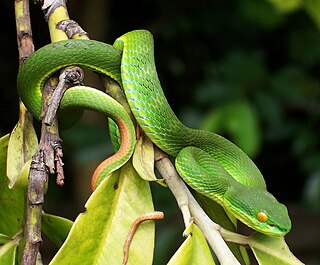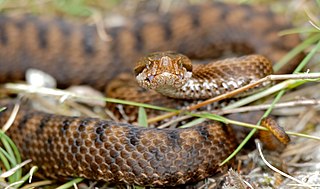In scaled reptiles, supraocular scales are (enlarged) scales on the crown immediately above the eye. [1] The size and shape of these scales are among the many characteristics used to differentiate species from each another.

Squamata is the largest order of reptiles, comprising lizards, snakes and amphisbaenians, which are collectively known as squamates or scaled reptiles. With over 10,000 species, it is also the second-largest order of extant (living) vertebrates, after the perciform fish, and roughly equal in number to the Saurischia. Members of the order are distinguished by their skins, which bear horny scales or shields. They also possess movable quadrate bones, making it possible to move the upper jaw relative to the neurocranium. This is particularly visible in snakes, which are able to open their mouths very wide to accommodate comparatively large prey. Squamata is the most variably sized order of reptiles, ranging from the 16 mm (0.63 in) dwarf gecko to the 5.21 m (17.1 ft) green anaconda and the now-extinct mosasaurs, which reached lengths of over 14 m (46 ft).

Eyes are organs of the visual system. They provide organisms with vision, the ability to receive and process visual detail, as well as enabling several photo response functions that are independent of vision. Eyes detect light and convert it into electro-chemical impulses in neurons. In higher organisms, the eye is a complex optical system which collects light from the surrounding environment, regulates its intensity through a diaphragm, focuses it through an adjustable assembly of lenses to form an image, converts this image into a set of electrical signals, and transmits these signals to the brain through complex neural pathways that connect the eye via the optic nerve to the visual cortex and other areas of the brain. Eyes with resolving power have come in ten fundamentally different forms, and 96% of animal species possess a complex optical system. Image-resolving eyes are present in molluscs, chordates and arthropods.
In many species of boids and viperids, the supraoculars are heavily fragmented. In others, such as the colubrids and elapids, they are enlarged.

Boids is an artificial life program, developed by Craig Reynolds in 1986, which simulates the flocking behaviour of birds. His paper on this topic was published in 1987 in the proceedings of the ACM SIGGRAPH conference. The name "boid" corresponds to a shortened version of "bird-oid object", which refers to a bird-like object. Incidentally, "boid" is also a New York Metropolitan dialect pronunciation for "bird".













